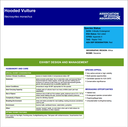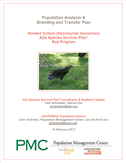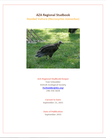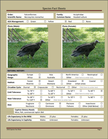-
Natural History
-
SSP
-
Organizations
-
Care Manual
<
>
conservation statusDiet
reproduction
|
Range and distributionSub-Saharan Africa, with a wide northern range from Senegal in the west to Ethiopia in the east. Populations are also resident in Angola, Zambia, Malawi, Tanzania, Burundi, Rwanda, and Uganda.
According to IUCN, the list of countries in which current populations have been found: Angola; Benin; Botswana; Burkina Faso; Burundi; Cameroon; Central African Republic; Chad; Congo, The Democratic Republic of the; Côte d'Ivoire; Djibouti; Eritrea; Ethiopia; Gambia; Ghana; Guinea; Guinea-Bissau; Kenya; Liberia; Malawi; Mali; Mauritania; Mozambique; Namibia; Niger; Nigeria; Rwanda; Senegal; Sierra Leone; Somalia; South Africa; South Sudan; Sudan; Swaziland; Tanzania, United Republic of; Togo; Uganda; Zambia; Zimbabwe. |
characteristics
- Wingspan: 5 feet
- Avg weight: 4-5 lbs
- Avg life span in captivity: 25-35 years
conservation issues
- According to Ogada & Buij, 2011, the maximum total population as of 2011 is 197,000 individual birds. The researchers also reported an average population decline across Africa of 62%, but a more recent paper by Ogada et al. in 2016 projected an 83% population decrease over 3 generations, qualifying them for the status of critically endangered.
- The largest threat facing hooded vultures is poisoning, primarily via agricultural pesticides. The main sources of poisoned carcasses are a) elephants or rhinos killed by poaching whose carcasses are poisoned to deter circling vultures from giving away the location of poaching events, b) large predators such as lions that were poisoned in retribution for killing livestock, and c) feral dogs that were poisoned in an effort to curb their population growth. The trade in traditional medicine and collisions with electrical infrastructure are also important causes of population decline.
Date of Last PVA/B&T Plan |
Current Population Size (N) |
Current Number of Participating AZA Member Institutions |
Projected % GD at 100 Years or 10 Generations |
SSP Program Designation |
5 Year Target Population Size |
Space Needed (Target population minus current space) |
Recent 5 Year Population Trend (increasing, decreasing, or stable) |
Studbook: 9/2015 B&T Plan: 1/2017 |
40 (21.17.2) |
9 |
43.3% |
Red SSP |
51 |
51-40 = 11 |
Stable |
|
Name
|
Organization
|
Position
|
|
SSP Program Leader & Studbook Keeper
Education Advisor |
|
An official Care Manual has not yet been written. However, please check out the fact sheet prepared by the SSP Program Leader and the Avian Scientific Advisory Group (ASAG).
|





